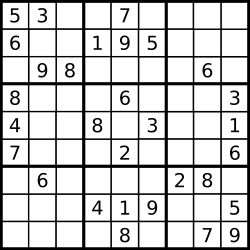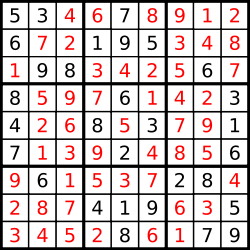数组类——二维数组
| 序号 | 题目 | 难度 | 代码 |
|---|---|---|---|
| 48 | Rotate Image | Medium | python、java、c++ |
| 54 | Spiral Matrix | Medium | python、java、c++ |
| 73 | Set Matrix Zeroes | Medium | python、java、c++ |
| 311 | Sparse Matrix Multiplication | medium | python、java、c++ |
| 36 | Valid Sudoku | meidum | python、java、c++ |
| 37 | Sudoku Solver | hard | python、java、c++ |
54. Spiral Matrix
Given a matrix of m x n elements (m rows, n columns), return all elements of the matrix in spiral order.
Example 1:
Input: [ [ 1, 2, 3 ], [ 4, 5, 6 ], [ 7, 8, 9 ] ] Output: [1,2,3,6,9,8,7,4,5]
Example 2:
Input: [ [1, 2, 3, 4], [5, 6, 7, 8], [9,10,11,12] ] Output: [1,2,3,4,8,12,11,10,9,5,6,7]
class Solution:
def spiralOrder(self, matrix: List[List[int]]) -> List[int]:
if len(matrix) == 0 or len(matrix[0]) == 0:
return []
ans = []
left, up, down, right = 0, 0, len(matrix) - 1, len(matrix[0]) - 1
while left <= right and up <= down:
for i in range(left, right + 1):
ans += matrix[up][i],
up += 1
for i in range(up, down + 1):
ans += matrix[i][right],
right -= 1
for i in reversed(range(left, right + 1)):
ans += matrix[down][i],
down -= 1
for i in reversed(range(up, down + 1)):
ans += matrix[i][left],
left += 1
return ans[:(len(matrix) * len(matrix[0]))]73. Set Matrix Zeroes
Given a m x n matrix, if an element is 0, set its entire row and column to 0. Do it in-place.
Example 1:
Input: [ [1,1,1], [1,0,1], [1,1,1] ] Output: [ [1,0,1], [0,0,0], [1,0,1] ]
Example 2:
Input: [ [0,1,2,0], [3,4,5,2], [1,3,1,5] ] Output: [ [0,0,0,0], [0,4,5,0], [0,3,1,0] ]
Follow up:
- A straight forward solution using O(mn) space is probably a bad idea.
- A simple improvement uses O(m + n) space, but still not the best solution.
- Could you devise a constant space solution?
class Solution:
def setZeroes(self, matrix: List[List[int]]) -> None:
"""
Do not return anything, modify matrix in-place instead.
"""
# First row has zero?
m, n, firstRowHasZero = len(matrix), len(matrix[0]), not all(matrix[0])
# Use first row/column as marker, scan the matrix
for i in range(1, m):
for j in range(n):
if matrix[i][j] == 0:
matrix[0][j] = matrix[i][0] = 0
# Set the zeros
for i in range(1, m):
for j in range(n - 1, -1, -1):
if matrix[i][0] == 0 or matrix[0][j] == 0:
matrix[i][j] = 0
# Set the zeros for the first row
if firstRowHasZero:
matrix[0] = [0] * n 311.sparse-matrix-multiplication
Given two sparse matrices A and B, return the result of AB.
You may assume that A's column number is equal to B's row number.
Example:
Input:
A = [ [ 1, 0, 0], [-1, 0, 3] ]
B = [ [ 7, 0, 0 ], [ 0, 0, 0 ], [ 0, 0, 1 ] ]
Output:
| 1 0 0 | | 7 0 0 | | 7 0 0 |
AB = | -1 0 3 | x | 0 0 0 | = | -7 0 3 | | 0 0 1 |
class Solution(object):
def multiply(self, A, B):
"""
:type A: List[List[int]]
:type B: List[List[int]]
:rtype: List[List[int]]
"""
ret = [[0 for j in range(len(B[0]))] for i in range(len(A))]
for i, row in enumerate(A):
for k, a in enumerate(row):
if a:
for j, b in enumerate(B[k]):
if b:
ret[i][j] += a * b
return ret36. Valid Sudoku
Determine if a 9x9 Sudoku board is valid. Only the filled cells need to be validated according to the following rules:
- Each row must contain the digits
1-9without repetition. - Each column must contain the digits
1-9without repetition. - Each of the 9
3x3sub-boxes of the grid must contain the digits1-9without repetition.

A partially filled sudoku which is valid.
The Sudoku board could be partially filled, where empty cells are filled with the character '.'.
Example 1:
Input: [ ["5","3",".",".","7",".",".",".","."], ["6",".",".","1","9","5",".",".","."], [".","9","8",".",".",".",".","6","."], ["8",".",".",".","6",".",".",".","3"], ["4",".",".","8",".","3",".",".","1"], ["7",".",".",".","2",".",".",".","6"], [".","6",".",".",".",".","2","8","."], [".",".",".","4","1","9",".",".","5"], [".",".",".",".","8",".",".","7","9"] ] Output: true
Example 2:
Input: [ ["8","3",".",".","7",".",".",".","."], ["6",".",".","1","9","5",".",".","."], [".","9","8",".",".",".",".","6","."], ["8",".",".",".","6",".",".",".","3"], ["4",".",".","8",".","3",".",".","1"], ["7",".",".",".","2",".",".",".","6"], [".","6",".",".",".",".","2","8","."], [".",".",".","4","1","9",".",".","5"], [".",".",".",".","8",".",".","7","9"] ] Output: false Explanation: Same as Example 1, except with the 5 in the top left corner being modified to 8. Since there are two 8's in the top left 3x3 sub-box, it is invalid.
Note:
- A Sudoku board (partially filled) could be valid but is not necessarily solvable.
- Only the filled cells need to be validated according to the mentioned rules.
- The given board contain only digits
1-9and the character'.'.- The given board size is always
9x9.
class Solution:
def isValidSudoku(self, board: List[List[str]]) -> bool:
map_row = [{} for _ in range(9)]
map_col = [{} for _ in range(9)]
map_cell = [[{} for _ in range(3)] for __ in range(3)]
for i in range(9):
for j in range(9):
char = board[i][j]
if char == '.': continue
if char in map_row[i]: return False
else: map_row[i][char] = [i,j]
if char in map_col[j]: return False
else: map_col[j][char] = [i,j]
if char in map_cell[int(i/3)][int(j/3)]: return False
else: map_cell[int(i/3)][int(j/3)][char] = [i,j]
return True37. Sudoku Solver
Write a program to solve a Sudoku puzzle by filling the empty cells.
A sudoku solution must satisfy all of the following rules:
- Each of the digits
1-9must occur exactly once in each row. - Each of the digits
1-9must occur exactly once in each column. - Each of the the digits
1-9must occur exactly once in each of the 93x3sub-boxes of the grid.
Empty cells are indicated by the character '.'.

A sudoku puzzle...

..and its solution numbers marked in red.
Note:
- The given board contain only digits
1-9and the character'.'. - You may assume that the given Sudoku puzzle will have a single unique solution.
- The given board size is always
9x9.
pass